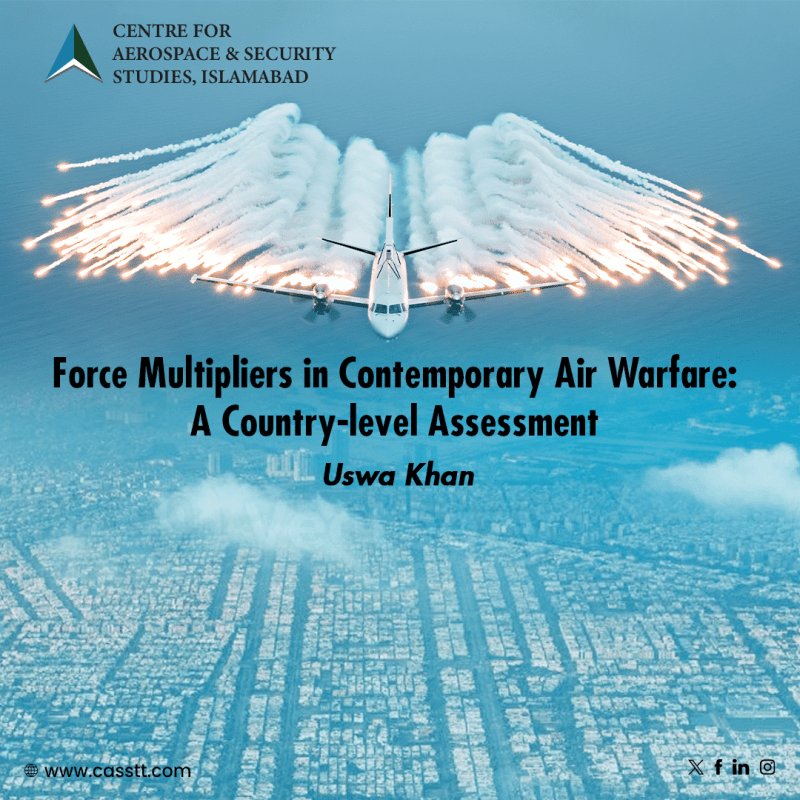Contemporary air warfare has significantly evolved across various levels of engagement. Recent combat trends in the Russia-Ukraine conflict highlight the changing nature of air warfare in this domain. During this conflict, the use of ‘Force Multipliers’(FMs) such as airborne warning and control systems (AWACS), air-to-air refuelers, and precision-guided munitions (PGMs) has demonstrated their efficacy and importance in achieving dominance over the adversary. In this context, it is important to assess the force multipliers being utilised by modern air forces worldwide.
The United States Air Force (USAF), renowned for its cutting-edge fleet of aerial platforms and powerful force multipliers, consistently strives to maintain its technological edge in the realm of AWACS. By 2027, the USAF plans to bolster this supremacy by inducting 26 state-of-the-art E-7A Wedgetail aircraft, setting a new standard for aerial command and control. The advanced capabilities of E-7A are likely to be much more than the existing E-3 AWACS already in service with the USAF. USAF also has diverse types of aerial tankers for refuelling with different ranges and storage capacities to cater to its operational requirements. These include KC-135 Stratotanker, KC-46 Pegasus, KC-10 Extender, and MC-130. The KC-135 Stratotanker remains the backbone of the USAF in executing refuelling missions. It has 294 KC-135 in service and reserve that can carry 90,719 kg of fuel.
China is also vying with the US for supremacy in the domain of force multipliers. It boasts a substantial fleet of three main AWACS types: the KJ-2000, the Shaanxi KJ-200, and the Shaanxi KJ-500, each deployed in significant quantities to enhance its strategic capabilities. Moreover, the People’s Liberation Army Air Force (PLAAF) has recently inducted eight advanced YY-20A air-to-air refuelers. These modernised refuelers are designed to support the PLAAF’s most sophisticated aircraft, including the J-10 and J-20, significantly enhancing their aerial refueling capabilities and extending their operational reach. They can carry 83000-90, 200 litre jet fuel which can provide refueling to multiple air aircraft in single sorties. Moreover, to enhance its precision strike capability, PLAAF is also procuring and inducting advanced PGMs. A new glide bomb designed to accurately destroy the adversary’s airfield, known as ‘Tianlei-500’ or ‘Sky Thunder-500’, was inducted recently by the PLAAF. The weapon is unique in its ability to devastate and render an area as large as 6,000 sq. meters unusable for immediate purposes.
In the subcontinent, the Indian Air Force (IAF) is investing heavily in FMs and inducting indigenous AWACS like Netra. It has ordered six Netra platforms to be inducted in the coming years. The NETRA AWACS will have a 500 km range far more than existing platforms in service with IAF. Besides indigenisation of these systems, the IAF already maintains three Israeli-supplied AWACS in active service. Apart from AWACS, it has six air-to-air refuelers to extend its combat aircraft mission ranges. IAF ordered six additional platforms last year to further augment the IAF asset capabilities to remain airborne. In terms of PGMs, the IAF has made significant investments, particularly after the Balakot incident, where it failed to accurately strike its target. Following its failure, IAF procured various domestic and foreign PGMs. One of them is the Israeli manufactured Rampage PGM, which can reach a maximum range of up to 250 km and hit its target with 10 meters circular error probable (CEP). Moreover, on the domestic side, ‘Gaurav’ PGM with 80 km has been in the production phase and would soon join the IAF’s operational fleet.
The Pakistan Air Force (PAF) initially purchased five SAAB-2000 AWACS from Sweden in 2006. To strengthen the fleet further, the PAF has also acquired additional AWACS from China. Besides AWACS, the PAF also inducted four Il-78MP air-to-air refueling aircraft in 2009. Since then, they have been part of the PAF’s operational force. PAF’s modern aircraft including JF-17s, and J-10s that can be refuelled mid-air. Additionally, the PAF procured modern PGMs enabling it to conduct precision strikes from long distances. This capability was effectively demonstrated during ‘Operation Swift Retort,’ where PAF planes successfully executed their mission, striking intended targets with PGMs.
Force Multipliers are now an integral part of the modern battlefield, providing a decisive edge that can influence the outcome of conflicts. Air forces worldwide recognise this shift, actively acquiring or developing these systems indigenously. Recent wars and conflicts have underscored the critical utility of AWACS, air-to-air refuelers, and PGMs in extending operational reach and ensuring precision strikes. Pakistan also realising this fact devotes due attention to the indigenisation process which will not only enhance the country’s defensive capabilities but also foster technological advancement and economic growth.
Uswa Khan is a Research Assistant at the Centre for Aerospace & Security Studies (CASS), Islamabad, Pakistan. She can be reached at [email protected].





